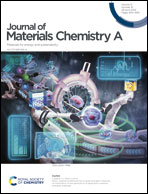In situ interphase engineering for all-solid-state Li batteries: a case study on the LiNi0.5Mn1.5O4/Li0.33La0.55TiO3 composite cathode guided by ab initio calculations†
Abstract
The sinterability and interfacial stability issues in the composite cathode have been the main bottlenecks of oxide-based all-solid-state Li battery development. The interfacial reaction between the electrode and electrolyte plays an important role in the sinterability and interfacial stability of a composite cathode. A suitable interfacial reaction can not only improve the sinterability by providing an additional driving force for chemical bond formation, but it can also stabilize the electrode/electrolyte interface by forming interfacial reaction products which remain stable during operation of the cell. In this work, a suitable dopant that can induce the formation of the desired interphase between the LiNi0.5Mn1.5O4 cathode and Li0.33La0.55TiO3 electrolyte was obtained through ab inito computational screening. Experimental verification was carried out by field-assisted sintering technology/spark plasma sintering (FAST/SPS) for obtaining mechanically stable composite cathode pellets and heat treatment for inducing the interfacial reaction. The dopant identified by computation was proven to induce the in situ formation of a stable protective layer. A successful method of simultaneously improving sinterability and interfacial stability in an oxide-based composite cathode is demonstrated in this work.



 Please wait while we load your content...
Please wait while we load your content...